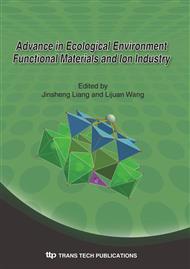p.71
p.75
p.81
p.87
p.93
p.99
p.105
p.111
p.117
Immobilized Bio-Beads with Activated Carbon Fiber for Removal of Benzene
Abstract:
Two kinds of new immobilized bio-beads in gel were produced with calcium alginate, polyvinyl alcohol and activated carbon fiber. Scanning electron microscopy was used to detect the microstructure and MB were applied to enhance degradation of benzene. It shows that activated carbon fiber was a excellent carrier material to increase MB stability and enhance the degradation of benzene by changing the microsructure. CA-MB in this study was characteristic of loose interface, intensely homogeneous holes and well-reusability. 80% of benzene could be reduced after120h and removal tallied with one-order knetics.Otherwise,for PVA-MB, it possed more compact ouside and irregular tunnles and poles inside.Benzene removal process was analysed to compose of absorption and biodegradation.The immobilization inoculum of 137.77mg/L was optimal with the most stabilities and the best degradation capability for both CA-MB and PVA-MB. Moreover, it is the addition of ACF as encapsulated carrier that made CA-MB superior to PVA-MB in benzene removal and reutilization.
Info:
Periodical:
Pages:
93-98
Citation:
Online since:
January 2010
Authors:
Price:
Сopyright:
© 2010 Trans Tech Publications Ltd. All Rights Reserved
Share:
Citation:


